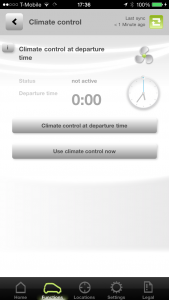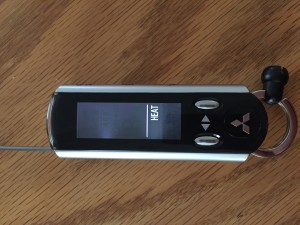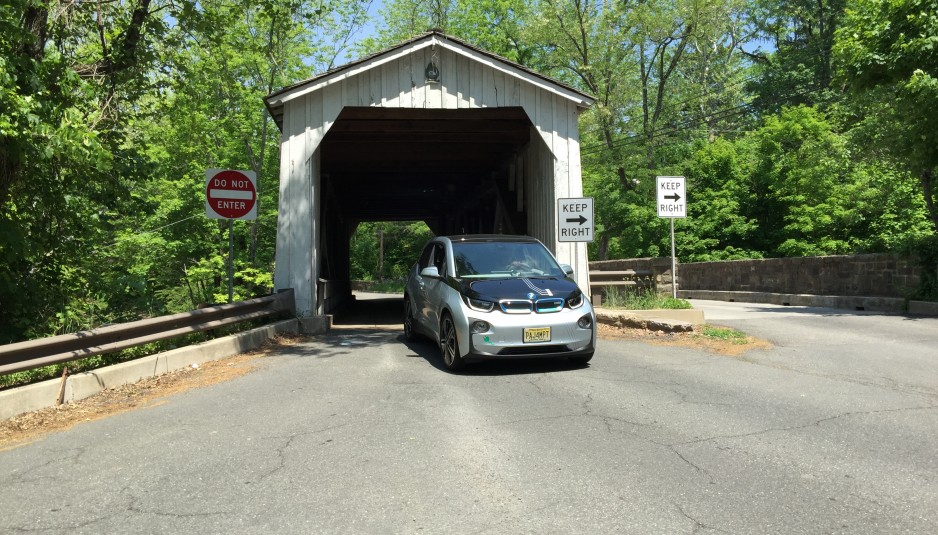Pre-Conditioning For Summer

Saturday 9th May 2015
What is pre-conditioning? This is the term used to describe the heating or cooling of your Electric Car interior before you need to leave your current abode.
In the dead of winter I wrote about the benefits of pre-heating your car but now summertime is on its way.
Being able to pre-condition is just one of the many great features about Electric Cars.
There’s nothing nicer, when it is boiling outside, than getting into a lovely cool car. We all like it but, if you own a petrol car you cannot do this. Well, you can but you shouldn’t as you are then idling, which is, in most US states illegal – although not enforced enough. You are also creating even more pollutants in an idling vehicle than one that is being driven. To overcome the heat and the slow engine speed, a petrol car has to use even more fuel than normal to keep itself going. And, do you know who suffers the most from idling vehicles? Children do! They stand closer to the tailpipe height than adults and breathe faster than adults. An idling vehicle has higher pollutants inside the vehicle too – Yuk!!
I’m often asked if our EV even has AC! It has to rate as being one of the most popular questions we get asked. Most people assume that, with a limited battery power, that AC would use too much energy and limit the range of the car. It turns out that most of that fear is based on experience with a petrol powered car. Here’s why… When a petrol car burns fuel, most of that is turned into heat, only 20-30% actually turns into motion. That motion is used to drive the AC compressor that provides the cool air inside the car. Early AC systems in cars used heavy fixed rate compressors driven off the engine – they were either on, or off, and they would cycle to prevent the system from turning its components into a block of ice! Cycling is inefficient for air conditioning systems.
Let’s add up the problems:
- Petrol cars waste 70-80% of the fuel that they burn
- AC systems in petrol cars have to cycle the compressor
- Petrol cars loose power and hence efficiency on hot days
- The waste heat from the engine acts like a furnace right in front of the occupants – so even more AC is needed to keep everyone cool
- Petrol is expensive – that gets people hot under the collar – which doesn’t help on a hot day either
It’s no wonder the fuel economy of petrol cars drops so much on hot days.
In electric vehicles, the AC compressor is driven off of a separate, highly efficient motor. The speed of the motor can be regulated to provide just enough cooling so no cycling and, there isn’t a huge furnace at the front trying to boil everyone in their seats! What this means is that the impact of AC in EVs is so much less that, the impact of range can be as little as just a few small percent.

When you are pre-conditioning your EV, you can leave the garage door closed as there are no stinky fumes to stink out your garage which is an added bonus especially if you have a garage that is attached to your house. There is no worry about adding to the rise in incidents of asthma in children – yes, it is happening. You are also not damaging your cars engine as EV’s don’t have one!

You checked the weather outside before you put your shoes on and decide that it would be nice to have a lovely cool EV ready for your departure. You can either program your EV to start cooling down from the settings on the car, the app on your smartphone, or the remote key fob. Pre-conditioning while still connected to the mains power is beneficial and results in more range as you are not using the batteries to cool the car which does eat into your range. Some EV’s can be lovely and cool to go in just a few minutes, others can take longer, depending on whether and how much power the AC system has and how well insulated the cabin is.
Over to my Chief Science/Technology Officer for the science behind pre-conditioning.
How can pre-cooling your car be more environmentally sound than not?
To answer that, we need to look at the numbers very closely.
Compared to the pre-heating in winter, pre-cooling is a more even playing field. Let’s assume that you are going to drive in a cool car. Cooling the car takes energy. Let’s assume, for example, that it takes an average car 15 minutes to cool down with its 5kW compressor built in. The power used to cool down is 5kW for ¼ hr or 1.25kWh of electricity. Once the car is cooled through, the AC cuts down power to 500W or less depending upon the outside temperature. That 15 mins of driving uses 500W x ¼hr or 0.125kWh of electricity but, wait, the power used whilst we’re driving is coming off of the main battery and that’s not 100% efficient! Let’s assume 85% efficiency for charging and discharging. That means that last 15 mins of driving with the AC on actually used an extra 15% or about 0.143kWh for a total power consumption, after 15 mins of driving of 1.393kWh. That’s about $0.21 and about 1.3lb of CO2 here in New Jersey. Let’s compare that to jumping in and driving away with the AC on. That’s 15 minutes of hot car cooling down at the full 5kW and, from the less than 100% efficient batteries. So, that’s 5kW x ¼ + 15% or, 1.44kWh and that’s about $0.22 but more importantly, it’s now 1.46lb of CO2.
There are always variables, if the battery is 95% efficient it’s a wash, if the battery is charged during off-peak base-load and preconditioned on higher polluting mid-day power, it’s a wash but, it’s seldom better to cool on battery and you’ll always loose the extra miles.
Being able to pre-condition is just one of the many great features about Electric Cars.




Comments